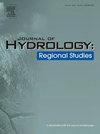基于灰色关系分析和 LSTM 模型的地下水动态聚类与预测:中国北京平原案例研究
IF 4.7
2区 地球科学
Q1 WATER RESOURCES
引用次数: 0
摘要
研究地区中国北京平原研究重点地下水系统的传统分区依赖于岩性特征和水力联系。然而,受气候变化和人类活动的影响,这些系统内部出现了多种多样的动态模式。此外,在使用机器学习方法建模时,地下水动态特征的差异往往被忽视。本研究提出了一种名为 GRA-CLU 的新聚类方法来划分地下水的动态类型。然后,使用基于动态分区的 LSTM 建立区域模型,旨在将水文地质意义纳入纯数据驱动模型:GRA-CLU 方法将研究区域划分为六个地下水动态类型。与传统的水文地质单元相比,新的分区结果发现了两个从未考虑过的动态类型:城市影响区和地表水与地下水相互作用的山原交界区。通过分析,2021 年地下水位的大幅上升更多是受暴雨事件而非人类活动的影响。本研究进一步探讨了基于六个动态区域的 LSTM 区域模型的性能。结果表明,模型的 NSE 增加了 5.7-50.0%,在不规则波动区的改善更为明显。均方根误差降低了 31.5-59.8%,在年波动规律和样本量大的区域尤为明显。本文章由计算机程序翻译,如有差异,请以英文原文为准。
Groundwater dynamics clustering and prediction based on grey relational analysis and LSTM model: A case study in Beijing Plain, China
Study region
Beijing Plain, China
Study focus
The traditional zoning of groundwater systems relies on lithological characteristics and hydraulic connections. However, the influence of climate change and human activities has led to the emergence of diverse dynamic patterns within these systems. Additionally, the differences in groundwater dynamic characteristics are often ignored when modeling with machine learning methods. In this study, a new clustering method named GRA-CLU was proposed to classify dynamic types of groundwater. Then, regional models are built using LSTM based on the dynamic zoning, aiming to incorporate hydrogeological significance into the pure data-driven model.
New hydrological insights for the region: The GRA-CLU method classified the study area into six groundwater dynamic types. Compared with the traditional hydrogeological units, the new zoning result identified two dynamic types that have never been considered: urban influence zone and mountain-plain junction zone where surface water interacts with groundwater. Through analysis, the significant rise of groundwater levels in 2021 was more influenced by heavy rainfall events rather than human activities. This study further explored the performance of LSTM regional models based on the six dynamic zones. The results indicated that the NSE of models increased by 5.7–50.0 %, the improvement was more obvious in zones with irregular fluctuations. The RMSE decreased by 31.5–59.8 %, particularly noticeable in zones with regular annual fluctuations and large samples.
求助全文
通过发布文献求助,成功后即可免费获取论文全文。
去求助
来源期刊

Journal of Hydrology-Regional Studies
Earth and Planetary Sciences-Earth and Planetary Sciences (miscellaneous)
CiteScore
6.70
自引率
8.50%
发文量
284
审稿时长
60 days
期刊介绍:
Journal of Hydrology: Regional Studies publishes original research papers enhancing the science of hydrology and aiming at region-specific problems, past and future conditions, analysis, review and solutions. The journal particularly welcomes research papers that deliver new insights into region-specific hydrological processes and responses to changing conditions, as well as contributions that incorporate interdisciplinarity and translational science.
 求助内容:
求助内容: 应助结果提醒方式:
应助结果提醒方式:


